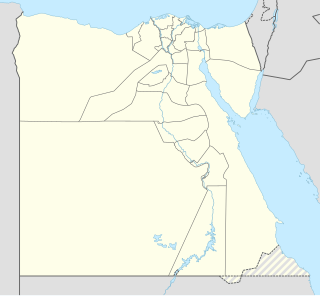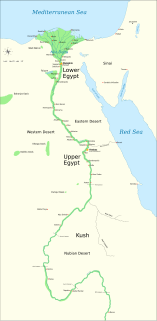Related Research Articles

Tomb KV5 is a subterranean, rock-cut tomb in the Valley of the Kings. It belonged to the sons of Ramesses II. Though KV5 was partially excavated as early as 1825, its true extent was discovered in 1995 by Kent R. Weeks and his exploration team. The tomb is now known to be the largest in the Valley of the Kings. Weeks' discovery is widely considered the most dramatic in the valley since the discovery of the tomb of Tutankhamun in 1922.

The First Intermediate Period, described as a 'dark period' in ancient Egyptian history, spanned approximately one hundred and twenty-five years, from c. 2181–2055 BC, after the end of the Old Kingdom. It comprises the Seventh, Eighth, Ninth, Tenth, and part of the Eleventh Dynasties. The concept of a "First Intermediate Period" was coined in 1926 by Egyptologists Georg Steindorff and Henri Frankfort.

Sehertawy Intef I was a local nomarch at Thebes during the early First Intermediate Period and the first member of the 11th Dynasty to lay claim to a Horus name. Intef reigned from 4 to 16 years c. 2120 BC or c. 2070 BC during which time he probably waged war with his northern neighbor, the Coptite nomarch Tjauti. Intef was buried in a saff tomb at El-Tarif, known today as Saff el-Dawaba.

Tomb KV14 is a joint tomb, used originally by Twosret and then reused and extended by Setnakhte. It has been open since antiquity, but was not properly recorded until Hartwig Altenmüller excavated it from 1983 to 1987.

Tomb WV25 in the West Valley of the Valley of the Kings, Egypt, is clearly the beginnings of a Royal Tomb, but was never finished or decorated. It is thought to be the start of Akhenaten's Theban Tomb.

Tomb KV61 is an unused tomb discovered in Egypt's Valley of the Kings. At discovery, it was apparently unused and undecorated, thus its intended owner is unknown. If used, it appears the burial was later moved in its entirety to another location. KV61 is an abbreviation for the Valley of the Kings, followed by a number to designate individual tombs in the Valley.

Tomb WV24 is an ancient Egyptian tomb located in the western arm of the Valley of the Kings. It was reported by Robert Hay and John Wilkinson in the 1820s and visited by Howard Carter; however, it was not fully explored until Otto Schaden's excavations in 1991.

Tomb KV28 is an ancient Egyptian tomb located in the Valley of the Kings in the Theban Necropolis in Upper Egypt. It was first excavated by persons unknown, and the recent excavations by Donald P. Ryan have found many damaged items from two individuals, possibly nobles of the nearby tomb of Thutmose IV.

Tomb KV30 is located in the Valley of the Kings in Egypt. It was discovered by Giovanni Belzoni in 1817, working on a commission from the Second Earl Belmore. As a consequence, it is also known as Lord Belmore's tomb.

Tomb KV29 is an ancient Egyptian tomb in the Valley of the Kings, located in the Theban Necropolis in Egypt.

Tomb KV27 is located in the Valley of the Kings in Egypt. This tomb was visited by John Wilkinson, but was not fully explored until 1990, by Donald P. Ryan of Pacific Lutheran University. The tomb is undecorated, and nothing is known about its occupant or occupants.

Tomb KV58 is located in the Valley of the Kings in Egypt. It is known as the Chariot Tomb, and consists of deposits from the tomb of Ay in WV23.

Tomb KV59 is located in the Valley of the Kings, in Egypt. It seems to be a tomb-commencement, but contained no remains.

Tomb KV50 is located in the Valley of the Kings, in Egypt. It contained the burial of a dog mummy and a mummified monkey, and is probably associated with the nearby tomb of Amenhotep II (KV35).

The Valley of the Kings, also known as the Valley of the Gates of the Kings, is a valley in Egypt where, for a period of nearly 500 years from the 16th to 11th century BC, rock cut tombs were excavated for the pharaohs and powerful nobles of the New Kingdom.

King Usermaatre Setepenre/SetepenamunShoshenq III ruled Egypt's 22nd Dynasty for 39 years according to contemporary historical records. Two Apis Bulls were buried in the fourth and 28th years of his reign and he celebrated his Heb Sed Jubilee in his regnal year 30. Little is known of the precise basis for his successful claim to the throne since he was not a son of Osorkon II and Shoshenq's parentage and family ties are unknown.

The Theban Necropolis is a necropolis on the west bank of the Nile, opposite Thebes (Luxor) in Upper Egypt. It was used for ritual burials for much of the Pharaonic period, especially during the New Kingdom.

The Book of Caverns is an important Ancient Egyptian netherworld book of the New Kingdom. Like all other netherworld books, it is also attested on the inside of kings’ tombs for the benefit of the deceased. It describes the journey of the sun god Ra through the six caverns of the underworld, focusing on the interaction between the sun god and the inhabitants of the netherworld, including rewards for the righteous and punishments for the enemies of the worldly order, those who fail their judgment in the afterlife. The Book of Caverns is one of the best sources of information about the Egyptian concept of hell.
The majority of the 65 numbered tombs in the Valley of the Kings can be considered minor tombs, either because at present they have yielded little information or because the results of their investigation was only poorly recorded by their explorers, while some have received very little attention or were only cursorily noted. Most of these tombs are small, often only consisting of a single burial chamber accessed by means of a shaft or a staircase with a corridor or a series of corridors leading to the chamber, but some are larger, multiple chambered tombs. These minor tombs served various purposes, some were intended for burials of lesser royalty or for private burials, some contained animal burials and others apparently never received a primary burial. In many cases these tombs also served secondary functions and later intrusive material has been found related to these secondary activities. While some of these tombs have been open since antiquity, the majority were discovered in the 19th and early 20th centuries during the height of exploration in the valley.
References
- ↑ "Theban Tomb #89 Epigraphic Project". Archived from the original on 2008-03-15. Retrieved 2007-05-02.
| This Ancient Egypt biographical article is a stub. You can help Wikipedia by expanding it. |